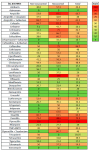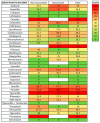Predominant Gram-Positive Etiology May Be Associated with a Lower Mortality Rate but with Higher Antibiotic Resistance in Spontaneous Bacterial Peritonitis: A 7-Year Study in a Tertiary Center in Romania
- PMID: 40566508
- PMCID: PMC12194169
- DOI: 10.3390/life15060855
Predominant Gram-Positive Etiology May Be Associated with a Lower Mortality Rate but with Higher Antibiotic Resistance in Spontaneous Bacterial Peritonitis: A 7-Year Study in a Tertiary Center in Romania
Abstract
(1) Background: Spontaneous bacterial peritonitis (SBP) is associated with a 20% mortality and is mainly caused by Gram-negative bacteria (GNB); Gram-positive bacteria (GPB) were predominant in some areas; and increased antibiotic resistance was recorded. (2) Methods: A retrospective study was performed between 2018 and 2024. The type of isolated strains, antibiotic susceptibility, and mortality (in-hospital; 30-day; 90-day; and 1-year) were estimated; multivariate analyses evaluated predictive factors for in-hospital mortality risk. (3) Results: 45 culture-positive SBP, 28 culture-negative SBP, 6 bacterascites, and 670 control ascites were diagnosed; GPB represented 60%; two Candida peritonitis and 11 polymicrobial peritonitis (21.6%) were noted (without surgery; peritoneal dialysis; or tegumentary lesion). High resistance rates to cephalosporins and quinolones, and high carbapenem resistance for nosocomial GNB were recorded. A low resistance rate to Tigecycline was noted in all infection types; GPB was susceptible to Linezolid and Vancomycin; and GNB was susceptible to Aztreonam and Colistin. In-hospital mortality was 26.7% (40% for GNB-SBP; 20% for GPB-SBP), similar to culture-negative SBP (21.3%), and higher than in the control group (9%); long-term mortality remained higher. (4) Conclusions: microbial changes to GPB etiology and increasing resistance were noted, but with a lower mortality compared to GNB; higher mortality rates up to 1 year for culture-positive and culture-negative SBP were recorded.
Keywords: antibiotic susceptibility; gram-negative bacteria; gram-positive bacteria; spontaneous bacterial peritonitis.
Conflict of interest statement
The authors declare no conflicts of interest.
Figures








Similar articles
-
Are third-generation cephalosporins still the empirical antibiotic treatment of community-acquired spontaneous bacterial peritonitis? A systematic review and meta-analysis.Eur J Gastroenterol Hepatol. 2018 Mar;30(3):329-336. doi: 10.1097/MEG.0000000000001057. Eur J Gastroenterol Hepatol. 2018. PMID: 29303883
-
Interventions to improve antibiotic prescribing practices for hospital inpatients.Cochrane Database Syst Rev. 2017 Feb 9;2(2):CD003543. doi: 10.1002/14651858.CD003543.pub4. Cochrane Database Syst Rev. 2017. PMID: 28178770 Free PMC article.
-
Characterising spontaneous bacterial peritonitis in liver cirrhosis and hepatocellular carcinoma in southwestern Nigeria.Ghana Med J. 2025 Jun;59(2):52-59. doi: 10.4314/gmj.v59i2.2. Ghana Med J. 2025. PMID: 40621408 Free PMC article.
-
Prophylactic antibiotics for preventing gram-positive infections associated with long-term central venous catheters in adults and children receiving treatment for cancer.Cochrane Database Syst Rev. 2021 Oct 7;10(10):CD003295. doi: 10.1002/14651858.CD003295.pub4. Cochrane Database Syst Rev. 2021. PMID: 34617602 Free PMC article.
-
Prophylactic antibiotics for adults with chronic obstructive pulmonary disease: a network meta-analysis.Cochrane Database Syst Rev. 2021 Jan 15;1(1):CD013198. doi: 10.1002/14651858.CD013198.pub2. Cochrane Database Syst Rev. 2021. PMID: 33448349 Free PMC article.
References
-
- European Association for the Study of the Liver EASL Clinical Practice Guidelines for the management of patients with decompensated cirrhosis. J. Hepatol. 2018;69:406–460. doi: 10.1016/j.jhep.2018.03.024. Corrected in J. Hepatol. 2018, 69, 1207. https://doi.org/10.1016/j.jhep.2018.08.009 . - DOI - PubMed
-
- Biggins S.W., Angeli P., Garcia-Tsao G., Ginès P., Ling S.C., Nadim M.K., Wong F., Kim W.R. Diagnosis, Evaluation, and Management of Ascites, Spontaneous Bacterial Peritonitis and Hepatorenal Syndrome: 2021 Practice Guidance by the American Association for the Study of Liver Diseases. Hepatology. 2021;74:1014–1048. doi: 10.1002/hep.31884. - DOI - PubMed
-
- Ascione T., Di Flumeri G., Boccia G., De Caro F. Infections in patients affected by liver cirrhosis: An update. Infez. Med. 2017;25:91–97. - PubMed
-
- Piano S., Singh V., Caraceni P., Maiwall R., Alessandria C., Fernandez J., Soares E.C., Kim D.J., Kim S.E., Marino M., et al. International Club of Ascites Global Study Group. Epidemiology and Effects of Bacterial Infections in Patients with Cirrhosis Worldwide. Gastroenterology. 2019;156:1368–1380.E10. doi: 10.1053/j.gastro.2018.12.005. - DOI - PubMed
-
- Voicu M.N., Popescu F., Florescu D.N., Rogoveanu I., Turcu-Stiolica A., Gheonea D.I., Iovanescu V.F., Iordache S., Cazacu S.M., Ungureanu B.S. Clostridioides difficile Infection among Cirrhotic Patients with Variceal Bleeding. Antibiotics. 2021;10:731. doi: 10.3390/antibiotics10060731. - DOI - PMC - PubMed
LinkOut - more resources
Full Text Sources

